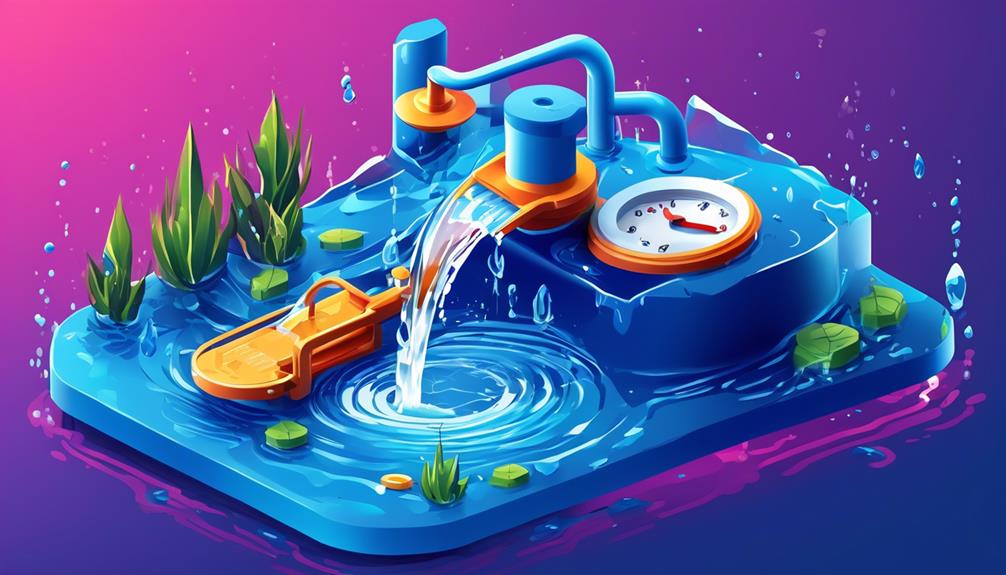I've always wondered about the actual impact of water conservation efforts. Are the statistics truly as alarming as they're made out to be?
It's surprising how much water we use on a daily basis without even realizing it. The numbers paint a stark picture of the impending water shortages and the urgency of taking action.
But what do these statistics really mean for the future of water conservation, and how can we make a difference?
Key Takeaways
- Less than 2% of the Earth's water supply is fresh water.
- Household leaks waste an average of 9,400 gallons of water per year.
- WaterSense labeled products lead to significant water savings and reduced household costs.
- 40 out of 50 state water managers anticipate shortages in the next decade.
The Importance of Water Conservation
Conserving water is essential for mitigating water shortages and reducing economic burdens on households. By replacing old, inefficient toilets with WaterSense labeled models, the average family can save 13,000 gallons of water and $130 in water costs annually.
Additionally, household leaks waste an average of 9,400 gallons of water each year, equivalent to over 300 loads of laundry. Outdoor water use contributes to over 30% of total household water consumption, and in arid regions, it can soar up to 60%.
It's crucial to recognize that less than 2% of the Earth's water supply is fresh water, emphasizing the importance of utilizing this resource efficiently.
Understanding the significance of water conservation isn't just about individual savings, but about ensuring a sustainable future for all. Small changes in our daily routines, such as fixing leaks, using water-efficient appliances, and being mindful of outdoor water usage, can collectively make a substantial impact.
With these statistics in mind, it's evident that each of us plays a crucial role in conserving water and alleviating the strain on our water supply.
Water Usage and Wastage Statistics

The significance of water conservation becomes even more apparent when considering the staggering water usage and wastage statistics in households. On average, each American uses 82 gallons of water per day at home, contributing to potential water shortages.
Upgrading to WaterSense labeled products, such as toilets, showerheads, and faucets, can save an average family hundreds of gallons of water and significant costs annually. Household leaks are also a significant issue, wasting an average of 9,400 gallons of water per year, with nationwide leaks squandering approximately 900 billion gallons of water annually.
Outdoor water use accounts for over 30% of total household water use on average, and in arid regions, it can reach up to 60%. It's crucial to note that less than 2% of the Earth's water supply is fresh water, with only 1% available for drinking, emphasizing the importance of water conservation efforts.
These statistics underscore the urgent need for individuals to be mindful of their water usage and take proactive steps to minimize wastage.
Impact of Global Water Conservation Efforts
Efforts to conserve water on a global scale are pivotal in addressing the impending water shortages and promoting sustainable water usage practices. As seen in the table below, various factors contribute to the impact of global water conservation efforts.
| Factors | Impact |
|---|---|
| WaterSense labeled products | Significant water savings and reduced household costs |
| Household leaks and inefficient outdoor | Major sources of water waste contributing to shortages |
| Less than 2% of Earth's water supply | Highlights critical need for conservation efforts |
| Increasing awareness and water-efficient | Essential for addressing global water scarcity and inequality |
These statistics underscore the importance of global water conservation efforts. WaterSense labeled products are effective in reducing water usage and cutting costs for households. Additionally, addressing household leaks and inefficient outdoor water use is crucial in combating water waste. Considering that less than 2% of the Earth's water supply is fresh water, it is imperative to conserve this resource. Increasing awareness and implementing water-efficient practices are key steps in addressing global water scarcity and unequal distribution.
Key Water Conservation Methods

Transitioning from the impact of global water conservation efforts, we can now explore key water conservation methods that can significantly contribute to addressing water scarcity and promoting sustainable water usage practices. Here are some effective methods that can make a real difference:
- Installing energy-efficient toilets: This simple upgrade can reduce water usage by up to 60%, conserving a significant amount of water with every flush.
- Upgrading to newer washing machine models: Newer models use just 23 gallons of water per load, a substantial improvement over the 41 gallons used by older models.
- Fixing household leaks: Addressing leaks promptly can save up to 10,000 gallons of water per year, making a meaningful impact on household water consumption.
- Using water consciously for car washing: Simply using a hose for rinsing a car instead of continuous running can save up to 100 gallons of water, promoting mindful water usage.
United States Water Conservation Statistics
In the United States, water conservation efforts have become increasingly crucial as 40 out of 50 state water managers anticipate shortages in various regions over the next decade (2014 Government Accountability Report). As the average American uses 82 gallons of water per day at home (USGS, 2015), it is essential to implement water-saving practices. Conserving water not only helps mitigate shortages but also reduces the economic burden on households. One effective way to achieve this is by using WaterSense labeled products, which are 20% more water-efficient and perform as well as or better than standard models. For instance, replacing old, inefficient toilets with WaterSense labeled models can save the average family 13,000 gallons of water and $130 in water costs per year. Here is a table summarizing key statistics related to water conservation in the United States:
| Fact | Source |
|---|---|
| 40 out of 50 state water managers anticipate shortages in the next decade | 2014 Government Accountability Report |
| Each American uses 82 gallons of water per day at home | USGS, 2015 |
| WaterSense labeled products are 20% more water-efficient | – |
| Replacing old toilets with WaterSense models saves 13,000 gallons of water per year | – |
Shocking Facts About Water Wastage

Did you know that the average American family can waste a shocking 9,400 gallons of water annually from household leaks? That's equivalent to over 300 loads of laundry! It's truly alarming how much water is being wasted unknowingly.
Here are some more shocking facts about water wastage:
- The average American uses an average of 82 gallons of water per day at home. This number may seem small, but it adds up significantly over time.
- Outdoor water use accounts for over 30% of total household water use on average and can reach up to 60% in arid regions. This emphasizes the need for mindful water usage, especially in areas prone to water scarcity.
- Less than 2% of the Earth's water supply is fresh water. With such a limited resource, it's crucial to conserve and protect our freshwater sources.
- Over 1 billion people lack access to clean water. This staggering statistic highlights the global water crisis and the importance of not taking clean water for granted.
It's important to be mindful of our water usage and take steps to conserve this precious resource.
Future Water Shortage Predictions

I've come across some alarming statistics regarding future water shortage predictions.
It's clear that the growing demand for water, coupled with the impact of climate change, is leading us towards a potential crisis.
We need to address these issues urgently to prevent severe water shortages in the future.
Growing Demand for Water
Amidst increasing water demands and looming predictions of future shortages, water conservation has become a critical necessity for sustainable resource management. The statistics are alarming:
- Over 40 out of 50 state water managers predict water shortages in several parts of their states within the next decade.
- The average American uses about 82 gallons of water per day at home, putting immense strain on water resources.
Water conservation is crucial to mitigate water shortages and alleviate economic burdens on households. The installation of WaterSense labeled products can result in significant water and cost savings for the average family.
These facts highlight the urgency for immediate action and the importance of individual and collective efforts in conserving water for a sustainable future.
Impact of Climate Change
With over 1 billion people currently lacking access to clean water, the impact of climate change on future water shortages is a pressing global concern. By 2025, an estimated 1,800 million people will live in areas affected by water scarcity, underscoring the severe implications of climate change.
The devastating consequences of inadequate sanitation and lack of clean water are evident, with 2,195 children worldwide succumbing to diarrhea every day. Unequal distribution further exacerbates global water scarcity, with 7 out of 10 people without access to clean water residing in rural areas.
It's vital to recognize that water conservation plays a pivotal role in averting future shortages. Every drop of water saved through conservation efforts contributes significantly to mitigating the impact of climate change on future water scarcity.
Urgent action is imperative to address climate change and ensure sustainable water resources for the future.
Frequently Asked Questions
What Are Some Innovative Technologies Being Used to Conserve Water?
I'm impressed by the innovative technologies used to conserve water. WaterSense products save significant water and electricity costs. Water-efficient irrigation systems and newer washing machine models also contribute to conserving water, showcasing advancements in water-efficient appliances.
How Do Different Regions Around the World Prioritize Water Conservation Efforts?
In different regions around the world, water conservation efforts are prioritized based on factors like population density, climate conditions, and available water resources. Local governments and communities implement various strategies to address their specific water conservation needs.
What Are the Economic Benefits of Water Conservation?
I'll discuss the economic benefits of water conservation. Conserving water can lower utility bills, reduce the need for costly infrastructure, and preserve natural resources. It's a win-win for both the environment and our wallets.
How Does Water Conservation Impact Wildlife and Ecosystems?
Water conservation positively impacts wildlife and ecosystems by preserving natural habitats, maintaining water sources, and supporting diverse plant and animal life. It helps mitigate the impact of droughts, reduces habitat degradation, and protects biodiversity.
What Role Do Government Policies Play in Promoting Water Conservation?
Government policies play a crucial role in promoting water conservation. They provide regulations, incentives, and support for efficient practices. Without these measures, achieving widespread conservation would be much more challenging, impacting our environment and resources.
Conclusion
In conclusion, it's clear that water conservation is crucial for our future.
The statistics show the urgency of the situation, but they also highlight the impact that simple changes in our daily habits can make.
By taking small steps to save water, we can all play a part in addressing global water scarcity.
Let's work together to make a difference and ensure a sustainable water future for generations to come.










